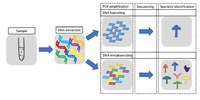
Photo from wikipedia
Analyzing predator scats for the presence of prey is a common noninvasive approach to understanding trophic interactions. Morphological analysis of prey remains has been the prevailing method of diet analysis,… Click to show full abstract
Analyzing predator scats for the presence of prey is a common noninvasive approach to understanding trophic interactions. Morphological analysis of prey remains has been the prevailing method of diet analysis, but molecular methods are becoming more widely used. Previous analyses suggest molecular methods detect target prey species more frequently than morphological methods. We compared these methods by analyzing coyote (Canis latrans) scats—collected in Tooele County, Utah, USA, in the winter of 2014—for leporids, a taxonomic group for which a molecular species identification test has been developed. We included 25 scats in which leporids were detected and 25 scats in which leporids were not detected by morphological methods. Additionally, because few studies have explored the effect of fecal sampling protocols on prey DNA detection, we analyzed subsamples taken from 5 locations on each scat to compare prey detection frequencies. We found that molecular analysis detected leporid prey in scats at a rate similar to or greater than morphological analysis, depending on the number of fecal sampling locations considered. Of the single samples, the homogenized (46%) and side (44%) samples provided the greatest rates of leporid prey DNA detection, followed by the ends (mean across both ends = 35%) and center (38%) of scats. When multiple sampling locations were considered, the homogenized-side combination (70%) had a detection rate similar to when all sampling locations were considered (76%). Our results indicate that molecular analysis detected prey more frequently than morphological analysis, but that prey detection was not equitable among fecal sampling locations and multiple sampling locations may be required. © 2017 The Wildlife Society.
Journal Title: Wildlife Society Bulletin
Year Published: 2017
Link to full text (if available)
Share on Social Media: Sign Up to like & get
recommendations!